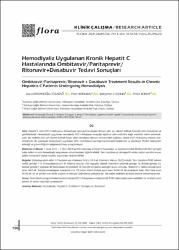| dc.contributor.author | Mistanoğlu Özatağ, Duru | |
| dc.contributor.author | Korkmaz, Pınar | |
| dc.contributor.author | Coşgun, Süleyman | |
| dc.contributor.author | Konya, Petek | |
| dc.date.accessioned | 2022-05-30T12:14:49Z | |
| dc.date.available | 2022-05-30T12:14:49Z | |
| dc.date.issued | 2021 | en_US |
| dc.identifier.issn | 1300-932X | |
| dc.identifier.uri | https://doi.org/10.5578/flora.20219620 | |
| dc.identifier.uri | https://hdl.handle.net/20.500.12933/1117 | |
| dc.description.abstract | Introduction: Hepatitis C virus (HCV) infection is common in patients with end-stage renal disease who need hemodialysis or peritoneal dialysis. HCV infection increases the risk of liver-related and all-cause mortality in patients undergoing hemodialysis. Therefore, treatment of HCV infection is recommended in all patients with end stage kidney damage regardless of the degree of fibrosis. In this study, we aimed to evaluate the efficacy and safety of paritaprevir/ritonavir/ombitasvir and dasabuvir (PrOD) treatment in CHC patients undergoing hemodialysis.
Materials and Methods: Patients who were followed up with the diagnosis of KHC in the Infectious Diseases and Gastroenterology Clinics between January 2017 and October 2019 and were included in routine hemodialysis program were evaluated. Demographic data of all patients were retrospectively evaluated from medical records in terms of treatment responses and side effects.
Results: Mean age of 12 patients included in the study was 64.6 +/- 10.4 years. Nine (75%) of the patients were males. PrOD treatment was given to all patients, ribavirin (200 mg/day) was added to the treatment in patients with genotype 1 and 1a (n= 4). Genotype 1b was found in eight patients, genotype 1 a in 2, genotype 1 in two patients. One patient was experienced in treatment. Three patients had compensated liver cirrhosis. At the 4th week of treatment, the virological response rate was 92%. The virological response rate at the end of treatment was 100% in patients who completed the treatment (n= 10). Sustained Virological Response rate in these patients was 100%. The most common side effects were palpitations and rising of blood pressure values. Two patients could not complete the treatment due to side effects.
Conclusion: PrOD regimen offers an easily tolerated treatment option with high virological response in the treatment of HCV infection in our patients under the hemodialysis program. | en_US |
| dc.language.iso | tur | en_US |
| dc.publisher | Bilimsel Tıp Yayınevi | en_US |
| dc.relation.isversionof | 10.5578/flora.20219620 | en_US |
| dc.rights | info:eu-repo/semantics/openAccess | en_US |
| dc.subject | Hemodialysis | en_US |
| dc.subject | Hepatitis C | en_US |
| dc.subject | Ombitasvir | en_US |
| dc.subject | Paritaprevir | en_US |
| dc.subject | Dasabuvir | en_US |
| dc.title | Hemodiyaliz Uygulanan Kronik Hepatit C Hastalarında Ombitasvir/Paritaprevir/ Ritonavir+Dasabuvir Tedavi Sonuçları | en_US |
| dc.title.alternative | Ombitasvir/Paritaprevir/Ritonavir + Dasabuvir Treatment Results in Chronic Hepatitis C Patients Undergoing Hemodialysis | en_US |
| dc.type | article | en_US |
| dc.authorid | 0000-0001-5055-1220 | en_US |
| dc.department | AFSÜ, Tıp Fakültesi, Dahili Tıp Bilimleri Bölümü, Enfeksiyon Hastalıkları Ana Bilim Dalı | en_US |
| dc.contributor.institutionauthor | Konya, Petek | |
| dc.identifier.volume | 26 | en_US |
| dc.identifier.issue | 4 | en_US |
| dc.identifier.startpage | 736 | en_US |
| dc.identifier.endpage | 741 | en_US |
| dc.relation.journal | Flora İnfeksiyon Hastalıkları ve Klinik Mikrobiyoloji Dergisi | en_US |
| dc.relation.publicationcategory | Makale - Uluslararası Hakemli Dergi - Kurum Öğretim Elemanı | en_US |
















